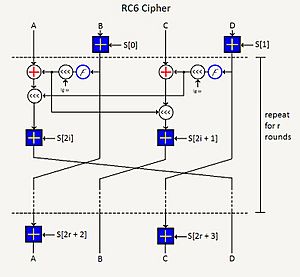RC6 facts for kids
|
The Feistel function of the RC6 algorithm.
|
|
| General | |
|---|---|
| Designers | Ron Rivest, Matt Robshaw, Ray Sidney, Yiqun Lisa Yin |
| First published | 1998 |
| Derived from | RC5 |
| Certification | AES finalist |
| Cipher detail | |
| Key sizes | 128, 192, or 256 bits |
| Block sizes | 128 bits |
| Structure | Feistel network (Type 2) |
| Rounds | 20 |
In the world of cryptography, RC6 is a special type of secret code. It's a symmetric-key block cipher, which means it uses the same secret key to both scramble (encrypt) and unscramble (decrypt) information. RC6 was created based on another code called RC5.
RC6 is very flexible! You can change its settings, like how big the chunks of data it scrambles are (called the block size), how long the secret key is (the key size), and how many times it mixes up the data (the number of rounds). The "RC" in RC6 stands for "Rivest Cipher," or sometimes "Ron's Code," named after one of its creators, Ron Rivest.
Contents
What is RC6 and How Does It Work?
RC6 is a way to protect digital information. Imagine you have a secret message. RC6 takes this message and turns it into a jumbled mess so no one else can read it. Only someone with the correct secret key can unscramble it back into the original message.
Why Was RC6 Created?
In 1997, a group called the NIST held a big competition. They wanted to find a new, super-strong secret code to replace an older one called Data Encryption Standard (DES). This new code would be known as the Advanced Encryption Standard (AES).
RC6 was specifically designed from its older brother, RC5, to try and win this competition. It was so good that it became one of the five finalists in the AES competition! Even though it wasn't chosen as the final standard, it showed how powerful and clever its design was.
How Flexible is RC6?
RC6 was built to be very adaptable, offering different levels of security and speed.
- For testing, it could handle small data blocks of 32 bits.
- For replacing older codes like DES, it could use 64-bit blocks.
- For the AES competition, it was designed for 128-bit blocks, which is very secure.
You can also change the number of "rounds" (how many times it mixes the data) from 0 to 255. The key size can also be very long, from 0 bits up to 2040 bits, making it incredibly hard for anyone to guess the secret key.
How is RC6 Different from RC5?
RC6 is quite similar to RC5, almost like two RC5 processes working side-by-side. But RC6 has some key differences that make it stronger and faster:
- It uses an extra math step called "multiplication" that RC5 doesn't have. This helps mix the data even more thoroughly.
- RC6 uses four special storage areas (called "registers") instead of two. Imagine these as small scratchpads where the code does its work.
Using four registers instead of two helps RC6 work better and faster on modern computers, especially those with 32-bit processors. The AES competition needed a code that could handle 128-bit blocks of data. RC5 would need 64-bit operations for this, but RC6 can do it using only 32-bit operations, which is more efficient for many computers.
Who Owns RC6?
RC6 is a proprietary and patented algorithm. This means it's owned by a company called RSA Security. If someone wants to use RC6 in their products, they might need to get permission and pay a fee.
The algorithm was created by a team of smart people: Ron Rivest, Matt Robshaw, Ray Sidney, and Yiqun Lisa Yin. Besides the AES competition, RC6 was also considered for other important projects like NESSIE and CRYPTREC, which also looked for strong encryption methods.
See also
 In Spanish: RC6 para niños
In Spanish: RC6 para niños


